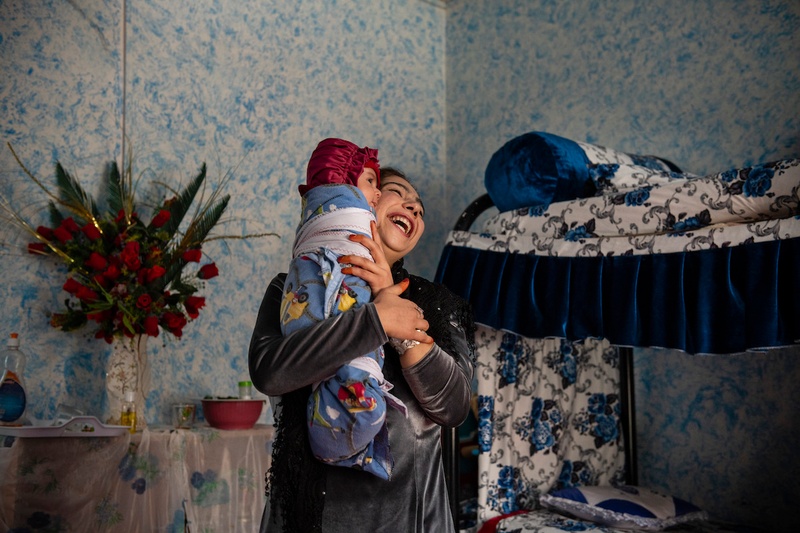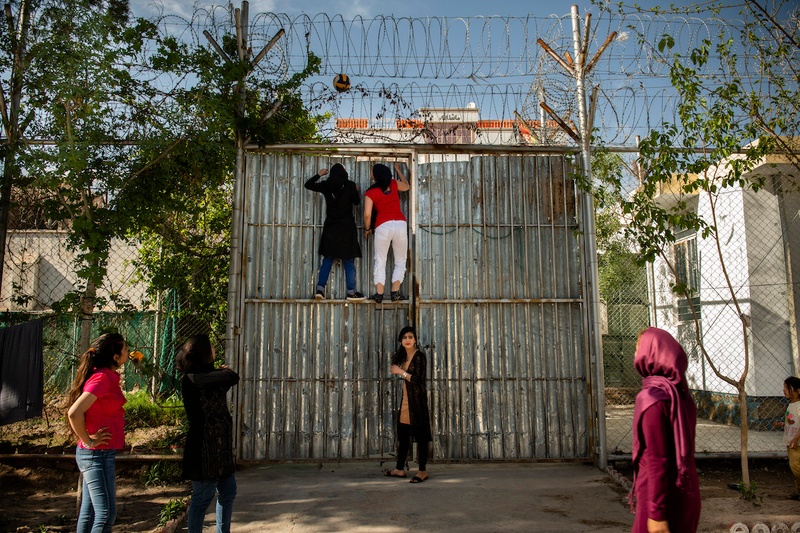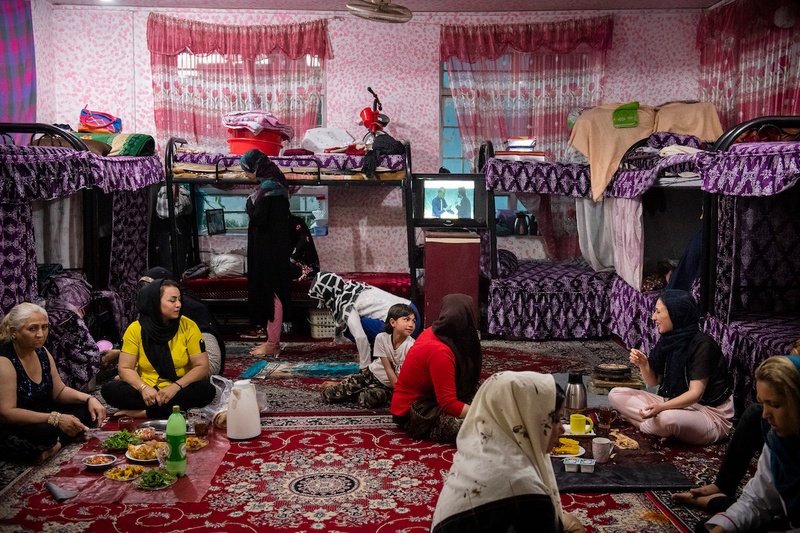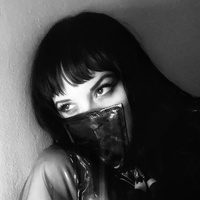On connecting to the world through your work
Prelude
Kiana Hayeri is a Senior TED fellow, a National Geographic Explorer grantee, and a regular contributor to The New York Times and National Geographic. She has been living in Afghanistan since 2014, not only covering the frontline and the dramatic events of war but also capturing a different and alternative narrative of America’s longest war by focusing on everyday life. In 2021, Kiana received the Robert Capa Gold Medal for her photographic series “Where Prison is a Kind of Freedom,” documenting the lives of Afghan women in Herat Prison. She is currently doing a Kickstarter campaign to create a photobook of that series.
Conversation
On connecting to the world through your work
Photographer Kiana Hayeri discusses what led her to taking pictures, gaining the trust of your subjects, and photography as a window to reality.
As told to Daniel Sharp, 2352 words.
Tags: Photography, Identity, Politics, Process, Collaboration.
When and why did you first pick up a camera?
I moved to Canada when I was 13 and then went back and forth until I was 16. I didn’t speak any English when I first started in Canada. So during high school I was taking English classes, ESL classes, and all the art classes. Photography felt right because I didn’t have to speak in the class. I did really well in that class. My teacher saw my excitement, so he gave me extra access to the dark room. I made friends through photography. I taught other kids. So now looking back, I understand it became a tool for me to connect with an environment that wasn’t my environment, that helped me turn that environment into my home. I think that theme has continued. When I insert myself into new spaces, the camera is still that tool.
The series you’re working on publishing right now, Where Prison is a Kind of Freedom, documents two weeks inside the Herat Women’s Prison. How were you first invited into the prison?
I wasn’t invited. I kind of made my way in it. It started back in 2016 when I was working on a different story about single mothers in Afghanistan. My housemate at the time was a producer on an Afghan TV show. Because I speak Farsi, he gave me the transcript so I could see how well it was translated. It was there that I noticed that in Farsi, and then later in Pashto, there is no word for a single mother. There’s millions of single mothers here, but they’re not acknowledged. There’s no title for them. They’re defined by the status of their marriage. They’re either divorced or widows.
I then learned that there are single moms raising their kids in prisons, so I visited the Herat Prison because it was the easiest to access. While I was taking interviews, I remember one woman from the other side of the room screaming at me. Like, saying things like, “What do you think I’m going to lose? I’ve killed my husband. I’ve lost my kids. I have nothing else to lose.” That really stayed with me.
Fast forwarding to 2018, I’m working on a different story about the mental health of Afghan women. I met this 17-year-old girl at the hospital who had attempted suicide four times by setting herself on fire. She did it to try and leave her abusive husband. She had a seven-months-old child at the time. It was then that I connected her with the woman who decided to kill her husband. That’s when I wanted to go back into Herat Women’s Prison and work with women who murdered the husband to get out of abuse and domestic violence, because they saw no other way of doing this.

In terms of access, we had a couple of meetings with management. They’re like, “Okay. Yeah, no problem,” and then I went in. The first two days I had a guard with me, which they said was to protect me from the prisoners. But I became friends with the female manager of the prison, and she invited me to go back two more times over the course of 15 days. I just kept going back. The more time I spent there, the more I became friends with the inmates, and the more they gave me access to their lives. The whole experience was full of surprises. And as much as you want to be objective, you have some ideas of what the story could be or is going to be. But it still surprised me.
You’re touching on how you built up trust between you, management, and the inmates. How did that process work for you?
It’s kind of a gamble—and more so after the fall of Kabul in 2021. If I go and do something with a group of people, I’m genuinely interested in them. If I show that interest and if I’m very sincere about what I’m doing, what I’m trying to do, it helps with access. I’ve learned, for example, if you spend some time with the camera on your shoulder for several hours, several days, without taking a single photo, it pays off in the long-term trust-wise. They know you’re there for them. You’re not trying to quickly do your thing and walk away. But when I say it’s a gamble, it’s really about how limited your time might be, especially nowadays with all the changes in Afghanistan. You could show up to a place, and it’s fine, fine, fine. Suddenly, the next moment it’s not fine, and everything flips.
Just yesterday, we finally got access to a very specific location that no other journalists had access to in the past. We worked for months just to get the green light. We were inside the space for two hours. Everything’s fine, got a tour of everything led by a Taliban commander. Then in the last three minutes, we’re walking out, everything flipped. A group of Taliban from another unit walked in. We’re briefly detained, then let go. So the time you have is unpredictable.
Let’s turn to the inmates you met in Herat Women’s Prison. What was the emotional gamut of their emotions? You mentioned one was frustrated, but did others perceive their situation as relief? Despair? Maybe even solidarity?
A mix of all of these things. It really felt like a dormitory for women, except they would never leave the dormitory. There were fights where people punched one another, but other times there would be a sense of community. There were groups of friends, where they would eat together, cook together. Some were poorer than others, so the ones who had money would lend them food items. They would raise each other’s kids. You could find a sense of solidarity. Lots of gossip. Some women at that time had phones, so talking to these boys outside who were considered to be their boyfriends.
I’m glad you brought up their children, too. As I looked at your photographs, a lot of them include many of the women’s children. I was curious from a structural or policy level, are they perceived as inmates too, or could they come and go?
If the mother didn’t have somebody to care for them, and the kids were below the age of five, they stayed inside the prison. When they were over five, they went to a safe house or orphanage that was run by a non-governmental organization at that time. But they could go in and out if they had family outside, yes.
The prison opened its gates and let all of the inmates out about three days before the Taliban took Kabul in 2021. Are you still in touch with some of them? If so, how are they doing?
So we don’t exactly know how many people were inside the prison on the day the Taliban took over, but yes, I am still in touch with some of them. I became very close with one of the characters at the prison. After she was released, I was involved in evacuating her out of Afghanistan. I’m in touch with two other prisoners who were inside the prison after the Taliban took over Afghanistan. A few of them are in Iran right now. One of them actually got remarried, and has had a baby since then. Foroozan is in Canada and reunited with all of her children. Two of the women that I photographed are back at the prison for other charges. One of them was for robbery. The other one I don’t know, but unfortunately they’re back in.
I’m fascinated by the idea that a prison could operate as a forum or frame for freedom. That’s primarily because I come from an American abolitionist context, where my country’s relationship to prisons is little more than present-day slavery. But I can only imagine the Afghan context to prisons is very different, right?
Yes. I think it’s important to say that not every prison looks like Herat Women’s Prison. The prison outside of Kabul, Pul-e-Charkhi, is horrendous. It was notorious even before the fall, and has since become even worse. Herat’s Prison was very well managed. It’s also important to look at Afghan society and draw a line between before and after the fall, because things have changed massively. But even before the fall, Afghan society was a very close society. Privacy is not defined. People walk into your room without knocking the door. You don’t have any privacy. When a woman gets married, she moves in with her husband and his family. So everybody lives together like a tribe. Many people, like ten people, can share one room. So in that larger context, a prison is a free space.

How does this specific prison complicate the relationship between who is oppressed and who is the oppressor?
That’s a tough one. The relationship between the prison guards, the management, and the inmates—they were almost like sisters. The inmates would help raise the prison guards’ kids. The prison manager would treat her staff and the inmates like family. If somebody would pass away, she went to pay her respect and give the staff days off. Within the prison’s four walls, there was no oppressed or oppressor. In the larger system when you’re dealing with judges and male figures, that changes quickly. But within that space, it was very equal.
I remember you called it prison almost like a commune.
Yes, almost.
So the power flows horizontally, or is at least exchanged.
Correct. Maybe one of the reasons I said it’s almost like a commune is, even within the prison there was still a little bit of hierarchy. There were a few inmates who had been there for many years, maybe two decades, who had a senior status. They would sometimes boss people around.

It sounds like your work acts as a window to a place that many of us don’t have access to. How can photography transform a story into a window that many didn’t know existed or even think to look through?
Photography is absolutely a window into stories like this. News loves to generalize any subject matter and put a big umbrella over something. I’m not saying photography is objective, but it’s a little more objective than words. With words, you’re constructing everything, which can make a huge difference. But with photos, yes, still as a creator you have a lot of power, but it’s still something that is seen. I think it’s very important in a place like Afghanistan which is a far, out-of-reach place for most people. It has been dominated by other people’s words for many, many years—two decades at least. And most of the news, it had a certain frame on it, right?
That’s why it is very important to me to have my work be little windows into people’s lives. It makes them human. It shortens the gap that horrendous events and words can create. Does that make sense?
Yeah. And a window opens up space for complication and nuance that general news will never get.
Correct, 100%.
I’m curious how you think the Afghan state perceived these women under the law. Did the women pose a threat in any way to certain power structures or culture?
So let’s break it down again into two answers. Before the fall, Afghan society was still very traditional, and for most part didn’t want women too involved in society. They belong to rooms away from everything else. But rules and laws were put in place by mostly Americans and Westerners because of the war. So if there was an issue, women did have a place to go to and make a complaint. How it was resolved, that’s questionable. But after the fall, any sense of legal protection disappeared. Society doesn’t give them those rights, nor the law, anymore.
Where Prison is a Kind of Freedom is becoming a book. What drew you to a book as a material for the project?
We’re so used to using our phones and screens to interact with images, that when they come, we look at them for a few seconds and move on. After that, we see images at an exhibition, right? You go and stand at a distance from a photo. You look at it and you walk away, but you can’t take it home. It stays with you just for a little bit.
A book, however, is something portable. It’s an object you hold, and it’s up close, and it stays with you. And the way we’re designing the book, it’s interactive. You’re opening things, going into spaces, out of the spaces. The book has a jacket that’s designed to have an “inside” and “outside.” It’s a theme that goes through the book. On the outside, it’s all these male-dominated spaces, and then you have to open the book in order to be able to see what’s happening inside. You’ll have to make the decision to remove the book’s jacket in order to see what’s underneath.
How can people outside the Afghan context bring light back into the country?
I’ve been encouraging people to contribute to non-governmental organizations that are doing work to fight poverty and hunger or girls’ education. One specific NGO has set up a network of hidden safe houses. They rescue women at risk and place them on a path to safety, which is amazing. Another has started to work with the Taliban to rescue young girls that are being sold by their families. That’s what I tell people who want to bring us little sparks and little hopes.
Kiana Hayeri Recommends:
- Name
- Kiana Hayeri
- Vocation
- photographer
Some Things
Pagination



